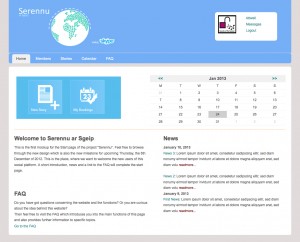Dysgu Ponty
The Pontydysgu website is always full of news about the big projects we are involved in, like FP7 Learning Layers or Taccle2. This is pretty inevitable as they take up the majority of our time and budget. However, there are lots of other, smaller Pontydysgu projects running in the background that we rarely post anything about. This is a bit of an oversight because although we often use these projects as test beds for trying out new ideas or as vehicles for piloting specific bits of technology that we then roll together in a much bigger package, they are also successful in their own right.
All of them are running in Pontypridd, (known locally as “Ponty”) which is where the Wales half of Pontydysgu is based. Some are part funded through the LLL Partnerships programme; some are funded in-house. We thought we might write a series of posts on what these projects are all about….
First up is Dysgu Ponty, which translates to Learning Ponty. We chose this name because apart from the play on Pontydysgu (meaning approximately Bridge to Learning), we wanted to convey the idea that the whole community of Ponty was learning and that the town called Ponty was a learning resource.
The project is based on a very simple concept – let’s cover the town with QR codes linked to a learning resource. The codes are being printed on decals (for shop windows), enamel (for the exteriors of building) and on varnished wooden plaques for hanging around trees in the park. Codes come in three colours – red for Welsh, green for the English translation and black for careers.
So far we have 200 and our target is at least another hundred. The town has a population of 30,000 but this covers all of the outlying villages as well. It also has a great sense of community, which means that the level of support has been brilliant. The whole community is involved – schools, the Town Council, shops, businesses, the local newspaper
The link from each QR code goes to a website page on which there is a question that relates to the location. The level is approximately 8 -12 yrs olds. Following the title question is some simple information using a range of multi media. The location of the codes will be on Google Maps and we are currently sorting them out into a ‘Maths trail’, ‘Language trail’, ‘History trail’ etc so that children can choose whether to follow a subject trail or focus on the codes in one part of the town.
The purpose of the project is really to provide a bridge between formal and informal learning and to improve home school links.
We are currently working of a way of ‘rewarding’ children for completing a number of questions – not sure Mozilla badges quite fits. Also thinking about how we can get kids to be able to upload pictures as well as comments. May rethink the platform.
Meanwhile here are some examples of the sorts of things we are talking about
Location: on the bandstand in the park
- Links to… Question: Have you ever heard brass band music?
- Additional ‘information’ – mp3 of Colliery Brass Band with one line of text explaining that most all the pits had their own band
Location: Outside Costa Coffee
- Links to… Question: Do you know where coffee comes from?
- Additional information: You Tube video of coffee being harvested and processed
Location: Outside travel agent underneath exchange rates
- Links to… Question: How much is it worth?
- Additional info: Text and image – If you had £37.50 to take on holiday, how many Euros would you get? Which travel agent in town has the best exchange rate today?
Location: On the river bank adjacent to the confluence
- Links to…mQuestion: What rivers are these and where is their source?
- Additional info: The place where two rivers merge is called a ‘confluence’. Use Google Earth to trace the two rivers back as far as you can, find out their names and where the river enters the sea.
Location: On the war memorial
- Links to… Question: How many died?
- Additional info: Look at the names on the Great War memorial and then the names on the Worls War 2 memorial. In which war were the greatest number of people from Pontypridd killed? How many times more people? Why do you think this was?
Location: Market Street
- Links to…Question: What has changed?
- Additional Info: Picture of the street taken 100 years ago from same spot. Text – List all the things that are different between Market Street in 1910 and the same street today.



